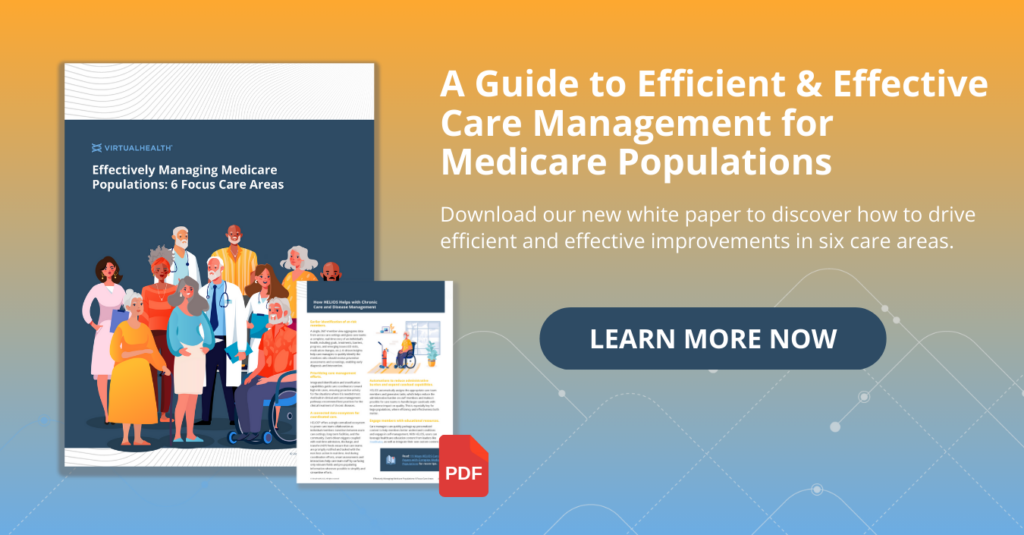This is the fifth article in a six-part series exploring ways to improve the delivery of whole-person, value-based care to Medicare and Medicare Advantage populations. In this post, we explain how to tackle challenges related to social determinants of health (SDOH) that can prevent members from experiencing optimal clinical outcomes.
You can also download our white paper Effectively Managing Medicare Populations: 6 Focus Care Areas to get more information and insights about other areas to improve for Medicare plan members.
Healthcare leaders increasingly are recognizing how critical it is to address and incorporate social determinants of health (SDOH) into value-based care models for Medicare Advantage members. Up to 80 percent of a patient’s health is determined by non-clinical factors like access to nutrition and transportation, geographic location, education level, economic stability, and community support resources.
Particularly among Medicare Advantage enrollees, SDOH-related challenges detract from overall health, quality of life, and care outcomes. One CMS study found that 1.4% of Medicare beneficiaries had an SDOH need documented in their medical claims data – and noted that these issues are likely underreported in the Medicare system. Homelessness and social isolation were noted as top SDOH challenges. The study concluded that health insurance plans should cover programs to address SDOH challenges like income, debt, food insecurity, lack of transportation, a member’s geographic location, and low literacy.
Address SDOH to Improve Member Health Outcomes and Quality of Life
Identifying and addressing SDOH for members can help enable better clinical outcomes and reduce costs by enabling greater, more equitable access to quality healthcare. Some of the benefits of addressing SDOH for Medicare Advantage members may include reduced hospital admissions, prevention of (or better management of) chronic conditions, and creating more engaged members.
How critical is SDOH? Let’s look at “access to transportation” as a specific SDOH challenge.
Without access to dependable transportation – an issue that’s especially prevalent among dual eligible enrollees – people are far less likely to seek preventive care and may need to reschedule or miss appointments due to being unable to get there. One survey found that 31 percent of Medicare and Medicaid beneficiaries missed provider appointments or ran out of medicine because they could not access transportation.
Another example emphasizes the opportunity to drive cost savings by implementing an SDOH program. See how HELIOS user Community Care of North Carolina (CCNC) implemented a program to address SDOH challenges among chronic disease patients who experienced these cost savings:
- 25% reduction in inpatient admissions
- Total net savings of $312 per member per year
- $3 in savings for the state for every $1 invested in CCNC
Download the VirtualHealth white paper below to learn how Lyft and CCNC worked to create healthier members by implementing innovative approaches to proactive care.
How HELIOS Can Help Medicare Payers Identify and Solve SDOH
HELIOS by VirtualHealth is a medical management platform that aligns care managers with clinical teams, social workers, behavioral healthcare professionals, and other key participants in a member’s healthcare. The platform also allows health plans to integrate with outside partners in the community, giving users the ability to quickly find services to meet non-clinical health needs and wrap them into a member’s care.
One source of member data. HELIOS serves as the single source of information for all of a Medicare or Medicare Advantage (including dual eligibles) enrollee’s healthcare diagnoses, events, treatment plans, care plans, and utilization management activities. This fosters collaborative decision-making and more efficient care coordination.
HELIOS empowers care managers to better address health plan members’ SDOH needs with the following capabilities:
Identification of members likely to experience SDOH challenges. Intelligent analytics surface population-level data that might indicate a member is more likely to experience SDOH challenges. This can help care managers identify when proactive outreach is needed to complete health-related social needs screenings, and further assessment and to connect the member with community resources, services and supports.
Automated alerts for missed medical services and items. HELIOS can notify care managers when a member misses an appointment or there are care gaps, such as missed wellness screenings, which can signal a lack of transportation or other issues preventing them from engaging in healthcare. A care manager can then reach out immediately to help identify the issue and work on a solution.
Expanded access with telemedicine. Built-in telehealth tools can expand care access by connecting with members virtually. For individuals who may have a smartphone but no access to Wi-Fi at home, this can go a long way in providing more equitable access to care for those who struggle to obtain it via more traditional methods.
Integrations with community resources and programs. HELIOS has a network of integrated partners who can help connect members to resources like food pantries and transportation providers. This empowers care managers to quickly link members with the services they need and help remove barriers to care. Closed-loop reporting can notify the care team when members engage with the service to create a fuller picture of member health activity and health-related social challenges.
Integrated education resources to improve health literacy. HELIOS partners with Healthwise, an industry leader in patient education. With a digital library of evidence-based health education resources, care managers can personalize education to a member’s health literacy level, specific need, and preferred learning modality within minutes.
How Can Care Managers Support SDOH Needs for Medicare Members?
Care managers are in a position to gain the trust of members and connect them to resources that can help bridge gaps related to SDOH challenges. [Discover how to create a closed-loop SDOH ecosystem and get tips from findhelp and NC INCK here on real-world SDOH approaches.]
- Stay alert for signs that a member may face non-clinical barriers to health. For example, are they missing appointments or failing to pick up prescriptions? Do they live in a neighborhood that lacks a well-stocked supermarket?
- Collaborate with others involved in the member’s care who may have key insight into SDOH needs.
- Align with community resources that serve needs related to SDOH, such as food pantries, transportation providers, social groups for seniors, and housing assistance groups.
- Provide resources to help elevate health literacy among Medicare populations.
Learn More About How to Improve Medicare Population Health Management
Check out the other five posts in this series to see how to improve medication adherence and outcomes for members who need additional support and services.
- How to Improve Medication Management for Medicare Populations
- How to Improve Care for Members with Medicare Who Need Long-term Services and Supports (LTSS)
- How to Integrate Behavioral Healthcare for Medicare Members
- How to Improve Chronic Condition Care Management
- How Can Medicare Payers Better Support Home Health Care?


